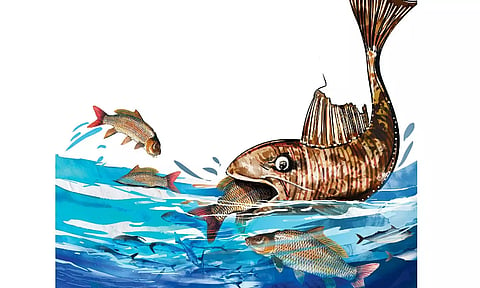

CHENNAI: A recent study has warned that the Cauvery and Pennar River basins in Tamil Nadu are vulnerable to invasion of Invasive Alien Fish species (IAF) due to the changing climate as well as the interlinking of rivers, which has been proposed and encouraged widely.
Moreover, import and export of aquarium fish from Chennai will also exacerbate the situation.
According to the study conducted by researchers in Ashoka Trust for Research in Ecology and the Environment (ATREE), based on the current species distribution models, the vulnerability of invasion of IAF has been identified in the Cauvery River basin in Karnataka and Tamil Nadu, the Pennar River basin mainly in Andhra Pradesh and Tamil Nadu, and the Krishna River basin that largely covers parts of Karnataka and Telangana.
“This scenario could be because Andhra Pradesh, Tamil Nadu, and Kerala are among the top five inland fisheries cultivating freshwater fish. Also, Chennai, and the port cities of Andhra Pradesh, are the biggest importers and exporters of varieties of aquarium fish in southern India,” the study pointed out.
Some widespread species like Pterygoplichthys (sailfin armoured catfish) that were introduced as ornamental fish in aquariums eventually entered the local waterbodies and are now hard to eliminate due to their highly adaptive life-history traits, the study added.
Meanwhile, projected climate change is also expected to cause significant shifts in the distribution ranges of species belonging to the family Poeciliidae including Gambusia (Mosquito fish) and P. reticulata (Guppy) with a shift towards the southwestern and northeastern India. The Greater Chennai Corporation had introduced Gambusia into the waterbodies in the city as part of mosquito control measure.
Meanwhile, the greatest potential for range expansion can be seen in Pterygoplichthys fish. Under one of the emission scenarios, C. gariepinus (African sharptooth catfish) increases its distribution range to 18.15%, while O. niloticus (Nile Tilapia) increases up to 29.33%, which is still a small increase compared to the 34% increase in Pterygoplichthys distribution. Under another scenario, O. niloticus and Pterygoplichthys have shown increases of 36% and 69.9%, respectively. There is a chance of 91% increase in the overall suitability of all 12 IAF species.
High vulnerability to invasion was observed in Godavari, Krishna, and Mahanadi rivers in addition to the Cauvery and Pennar.
The study warns that the interlinking of rivers has the potential to connect vulnerable areas that harbour threatened fish species to IAF hot spots. Explosive breeders like Gambusia and Poecilia (mollies) are capable of adapting to a wide range of environmental conditions. River linking can introduce these species into sensitive zones, leading to negative impacts on the local biodiversity
Another consequence of river linking is the potential increase in the distribution of Pterygoplichthys, which have shown a positive correlation with climate change. This species pose a significant threat to native species and cause substantial economic losses in commercial fisheries and are difficult to eradicate, the study highlighted.
“An important link to note in the peninsular (river linking) component is the Pennar-Cauvery link connecting the rivers Krishna and Pennar with the Palar and leading to the Cauvery basin. The Cauvery-Vaigai link channels the excess water of the Cauvery to the Vaigai and further creates pathways for IAF to spread. The Pamba-Achankovil-Vaippar link connects parts of the southern Western Ghats, which is a hotspot for endemic fishes in India,” the study report pointed out.
Saying that most of the IAF in India, (except Gambusia, P. reticulata, and Pterygoplichthys) are edible, the researchers urged to create awareness about the culinary uses of IAF to reduce the impacts of IAF while effectively helping with the monitoring and early detection of IAF as well as improving the local economy. They also emphasise rethinking when connecting waterways.